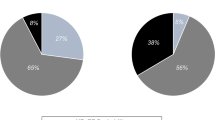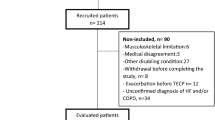Abstract
Good quality of life correlates with a good exercise capacity in daily life in patients with tetralogy of Fallot (ToF). Patients after correction of ToF usually develop residual defects such as pulmonary regurgitation or stenosis of variable severity. However, the importance of different hemodynamic parameters and their impact on exercise capacity is unclear. We investigated several hemodynamic parameters measured by cardiovascular magnetic resonance (CMR) and echocardiography and evaluated which parameter has the most pronounced effect on maximal exercise capacity determined by cardiopulmonary exercise testing (CPET). 132 patients with ToF-like hemodynamics were tested during routine follow-up with CMR, echocardiography and CPET. Right and left ventricular volume data, ventricular ejection fraction and pulmonary regurgitation were evaluated by CMR. Echocardiographic pressure gradients in the right ventricular outflow tract and through the tricuspid valve were measured. All data were classified and correlated with the results of CPET evaluations of these patients. The analysis was performed using the Random Forest model. In this way, we calculated the importance of the different hemodynamic variables related to the maximal oxygen uptake in CPET (VO2%predicted). Right ventricular pressure showed the most important influence on maximal oxygen uptake, whereas pulmonary regurgitation and right ventricular enddiastolic volume were not important hemodynamic variables to predict maximal oxygen uptake in CPET. Maximal exercise capacity was only very weakly influenced by right ventricular enddiastolic volume and not at all by pulmonary regurgitation in patients with ToF. The variable with the most pronounced influence was the right ventricular pressure.


Similar content being viewed by others
References
Muller J, Hager A, Diller GP, Derrick G, Buys R, Dubowy KO et al (2015) Peak oxygen uptake, ventilatory efficiency and QRS-duration predict event free survival in patients late after surgical repair of tetralogy of Fallot. Int J Cardiol 196:158–164
Mueller GC, Sarikouch S, Beerbaum P, Hager A, Dubowy KO, Peters B et al (2013) Health-related quality of life compared with cardiopulmonary exercise testing at the midterm follow-up visit after tetralogy of Fallot repair: a study of the German competence network for congenital heart defects. Pediatr Cardiol 34(5):1081–1087
Geva T (2013) Indications for pulmonary valve replacement in repaired tetralogy of fallot: the quest continues. Circulation 128(17):1855–1857
Greutmann M (2016) Tetralogy of Fallot, pulmonary valve replacement, and right ventricular volumes: are we chasing the right target? Eur Heart J 37(10):836–839
O’Byrne ML, Glatz AC, Mercer-Rosa L, Gillespie MJ, Dori Y, Goldmuntz E et al (2015) Trends in pulmonary valve replacement in children and adults with tetralogy of fallot. Am J Cardiol 115(1):118–124
Fratz S, Janello C, Muller D, Seligmann M, Meierhofer C, Schuster T et al (2013) The functional right ventricle and tricuspid regurgitation in Ebstein’s anomaly. Int J Cardiol 167(1):258–261
Fratz S, Schuhbaeck A, Buchner C, Busch R, Meierhofer C, Martinoff S et al (2009) Comparison of accuracy of axial slices versus short-axis slices for measuring ventricular volumes by cardiac magnetic resonance in patients with corrected tetralogy of fallot. Am J Cardiol 103(12):1764–1769
Meierhofer C, Lyko C, Schneider EP, Stern H, Martinoff S, Hess J et al (2015) Baseline correction does not improve flow quantification in phase-contrast velocity measurement for routine clinical practice. Clin Imaging 39(3):427–431
Muller J, Christov F, Schreiber C, Hess J, Hager A (2009) Exercise capacity, quality of life, and daily activity in the long-term follow-up of patients with univentricular heart and total cavopulmonary connection. Eur Heart J 30(23):2915–2920
Muller J, Hess J, Hager A (2013) Sense of coherence, rather than exercise capacity, is the stronger predictor to obtain health-related quality of life in adults with congenital heart disease. Eur J Prev Cardiol 21(8):949–955
Strobl C, Hothorn T, Zeileis A (2009) Party on! new, conditional variable-importance measure for random forests available in the party package. R J 1(2):14–17
Breiman L (2001) Random forests. Mach Learn 45(1):5–32
Strobl C, Boulesteix AL, Kneib T, Augustin T, Zeileis A (2008) Conditional variable importance for random forests. BMC Bioinformatics 9:307
van Buuren S (2007) Multiple imputation of discrete and continuous data by fully conditional specification. Stat Methods Med Res 16(3):219–242
Lurz P, Riede FT, Taylor AM, Wagner R, Nordmeyer J, Khambadkone S et al (2014) Impact of percutaneous pulmonary valve implantation for right ventricular outflow tract dysfunction on exercise recovery kinetics. Int J Cardiol 177(1):276–280
Lurz P, Nordmeyer J, Giardini A, Khambadkone S, Muthurangu V, Schievano S et al (2011) Early versus late functional outcome after successful percutaneous pulmonary valve implantation: are the acute effects of altered right ventricular loading all we can expect? J Am Coll Cardiol 57(6):724–731
Batra AS, McElhinney DB, Wang W, Zakheim R, Garofano RP, Daniels C et al (2012) Cardiopulmonary exercise function among patients undergoing transcatheter pulmonary valve implantation in the US Melody valve investigational trial. Am Heart J 163(2):280–287
Biernacka EK, Piotrowicz E, Fronczak A, Mazgaj M, Demkow M, Ruzyllo W et al (2015) Influence of percutaneous pulmonary valve implantation on exercise capacity: which group of patients benefits most from the intervention? Cardiol J. 22(3):343–350
Bokma JP, Winter MM, Oosterhof T, Vliegen HW, van Dijk AP, Hazekamp MG et al (2016) Preoperative thresholds for mid-to-late haemodynamic and clinical outcomes after pulmonary valve replacement in tetralogy of Fallot. Eur Heart J 37(10):829–835
Valente AM, Gauvreau K, Assenza GE, Babu-Narayan SV, Schreier J, Gatzoulis MA et al (2014) Contemporary predictors of death and sustained ventricular tachycardia in patients with repaired tetralogy of Fallot enrolled in the INDICATOR cohort. Heart 100(3):247–253
Funding
There was no funding for this study.
Author information
Authors and Affiliations
Corresponding author
Ethics declarations
Conflict of interest
All authors declare that they have no conflict of interest.
Ethical Approval
All procedures performed in studies involving human participants were in accordance with the ethical standards of the institutional and/or national research committee and with the 1964 Helsinki declaration and its later amendments or comparable ethical standards.
Informed Consent
Informed consent was obtained from all individual participants included in the study.
Rights and permissions
About this article
Cite this article
Meierhofer, C., Tavakkoli, T., Kühn, A. et al. Importance of Non-invasive Right and Left Ventricular Variables on Exercise Capacity in Patients with Tetralogy of Fallot Hemodynamics. Pediatr Cardiol 38, 1569–1574 (2017). https://doi.org/10.1007/s00246-017-1697-3
Received:
Accepted:
Published:
Issue Date:
DOI: https://doi.org/10.1007/s00246-017-1697-3




